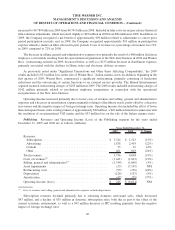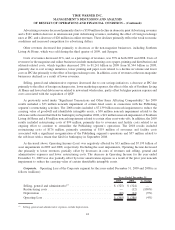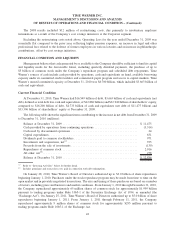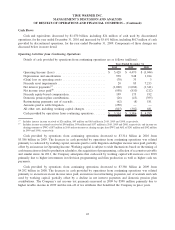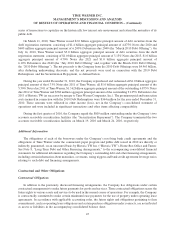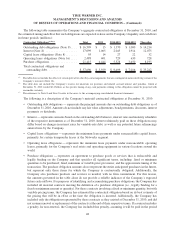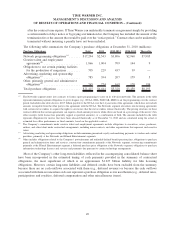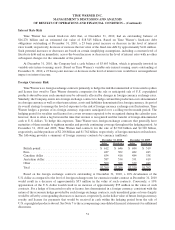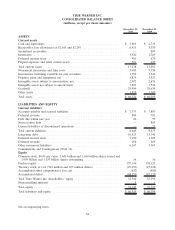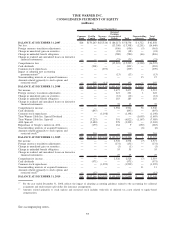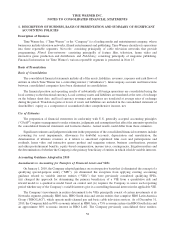Time Magazine 2010 Annual Report Download - page 62
Download and view the complete annual report
Please find page 62 of the 2010 Time Magazine annual report below. You can navigate through the pages in the report by either clicking on the pages listed below, or by using the keyword search tool below to find specific information within the annual report.
Future Film Licensing Obligations
In addition to the purchase obligations previously discussed, the Company has certain future film licensing
obligations, which represent studio movie deal commitments to acquire the right to air movies that will be released
in the future (i.e., after December 31, 2010). These arrangements do not meet the definition of a purchase obligation
since there are neither fixed nor minimum quantities under the arrangements. Because future film licensing
obligations are significant to its business, the Company has summarized these arrangements below. Given the
variability in the terms of these arrangements, significant estimates were involved in the determination of these
obligations, including giving consideration to historical box office performance and studio release trends. Actual
amounts, once known, could differ significantly from these estimates (millions).
Total 2011 2012-2013 2014-2015 Thereafter
Future Film Licensing Obligations......... $ 4,546 $ 563 $ 1,331 $ 1,513 $ 1,139
Contingent Commitments and Programming Licensing Backlog
The Company has certain contractual arrangements that would require it to make payments or provide funding
if certain circumstances occur. In addition, the Company has contractual arrangements for the licensing of theatrical
and television product for which the telecast period has not yet commenced and for which the Company has not yet
recorded the related revenue. See Note 16, “Commitments and Contingencies,” to the accompanying consolidated
financial statements for further discussion of these items.
Customer Credit Risk
Customer credit risk represents the potential for financial loss if a customer is unwilling or unable to meet its
agreed upon contractual payment obligations. Credit risk in the Company’s businesses originates from sales of
various products or services and is dispersed among many different counterparties. At December 31, 2010, no single
customer had a receivable balance greater than 5% of total receivables. The Company’s exposure to customer credit
risk is largely concentrated in the following categories (amounts presented below are net of reserves and
allowances):
• Various retailers for home video product of approximately $730 million;
• Various cable and broadcast TV network operators for licensed TV and film product of approximately
$2.2 billion;
• Various magazine wholesalers related to the distribution of published product of approximately
$130 million;
• Various cable system operators, satellite distribution services, telephone companies and other distributors
for the distribution of television programming services of approximately $1.2 billion; and
• Various advertisers and advertising agencies related to advertising services of approximately $1.3 billion.
For additional information regarding Time Warner’s accounting policies relating to customer credit risk, refer
to Note 1, “Description of Business, Basis of Presentation and Summary of Significant Accounting Polices,” to the
accompanying consolidated financial statements.
MARKET RISK MANAGEMENT
Market risk is the potential gain/loss arising from changes in market rates and prices, such as interest rates,
foreign currency exchange rates and changes in the market value of financial instruments.
50
TIME WARNER INC.
MANAGEMENT’S DISCUSSION AND ANALYSIS
OF RESULTS OF OPERATIONS AND FINANCIAL CONDITION – (Continued)


